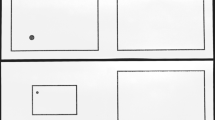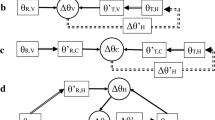Abstract
It has been argued that representations of peripersonal space based on haptic input are systematically distorted by egocentric reference frames. Interestingly, a recent study has shown that noninformative vision (i.e., freely viewing the region above the haptic workspace) improves performance on the so-called haptic parallel-setting task, in which participants are instructed to rotate a test bar until it is parallel to a reference bar. In the present study, we made a start at identifying the different sensory integration mechanisms involved in haptic space perception by distinguishing the possible effects of orienting mechanisms from those of noninformative vision. We found that both the orienting direction of head and eyes and the availability of noninformative vision affect parallel-setting performance and that they do so independently: orienting towards a reference bar facilitated the parallel-setting of a test bar in both no-vision and noninformative vision conditions, and noninformative vision improved performance irrespective of orienting direction. These results suggest the effects of orienting and noninformative vision on haptic space perception to depend on distinct neurocognitive mechanisms, likely to be expressed in different modulations of neural activation in the multimodal parietofrontal network, thought to be concerned with multimodal representations of peripersonal space.


Similar content being viewed by others
References
Annett M (1970) A classification of hand preference by association analyses. Br J Psychol 61:303–321
Driver J, Grossenbacher PJ (1996) Multimodal constraints on tactile selective attention. In: Inui T, McClelland JL (eds) Attention and performance XVI. MIT Press, Cambridge, MA, pp 209–235
Graziano MS (2002) Where is my arm? The relative role of vision and proprioception in the neuronal representation of limb position. Proc Natl Acad Sci USA 96:10418–10421
Honoré J, Bourdeaud’hui M, Sparrow L (1989) Reduction of cutaneous reaction time by direction eyes towards the source of stimulation. Neuropsychologia 27:367–371
Kappers AML (2002) Haptic perception of parallelity in the midsagittal plane. Acta Psychol 109:25–40
Kappers AML (2003) Large systematic deviations in a bimanual parallelity task: further analysis of contributing factors. Acta Psychol 114:131–145
Kappers AML, Koenderink JJ (1999) Haptic perception of spatial relations. Perception 28:781–795
Kennett S, Taylor-Clarke M, Haggard P (2001) Noninformative vision improves the spatial resolution of touch in humans. Curr Biol 11:1188–1191
Làdavas E, Di Pellegrino G, Farnè A, Zeloni G (1998) Neuropsychological evidence of an integrated visuotactile representation of peripersonal space in humans. J Cog Neurosci 10:581–589
Lloyd DM, Shore DI, Spence C, Calvert GA (2003) Multisensory representation of limb position in human premotor cortex. Nat Neurosci 6:17–18
Newport R, Hindle JV, Jackson SR (2001) Links between vision and somatosensation: vision can improve the felt position of the unseen hand. Curr Biol 11:975–980
Newport R, Rabb B, Jackson SR (2002) Noninformative vision improves haptic spatial perception. Curr Biol 12:1661–1664
Obayashi S, Tanaka M, Iriki A (2000) Subjective image of invisible hand coded by monkey intraparietal neurons. Neuroreport 11:3499–3505
Taylor-Clarke M, Kennett S, Haggard P (2002) Vision modulates somatosensory cortical processing. Curr Biol 12:233–236
Van Beers RJ, Sittig AC, Denier van der Gon JJ (1999) Localisation of a seen finger is based exclusively on propioception and on vision of the finger. Exp Brain Res 125:43–49
Zuidhoek S, Kappers AML, Van der Lubbe R, Postma A (2003) Delay improves performance on a haptic spatial matching task. Exp Brain Res 149:320–330
Acknowledgement
This research was supported by a grant from the Netherlands Organization for Scientific Research (NWO: 440-20-000).
Author information
Authors and Affiliations
Corresponding author
Rights and permissions
About this article
Cite this article
Zuidhoek, S., Visser, A., Bredero, M.E. et al. Multisensory integration mechanisms in haptic space perception. Exp Brain Res 157, 265–268 (2004). https://doi.org/10.1007/s00221-004-1938-6
Received:
Accepted:
Published:
Issue Date:
DOI: https://doi.org/10.1007/s00221-004-1938-6




